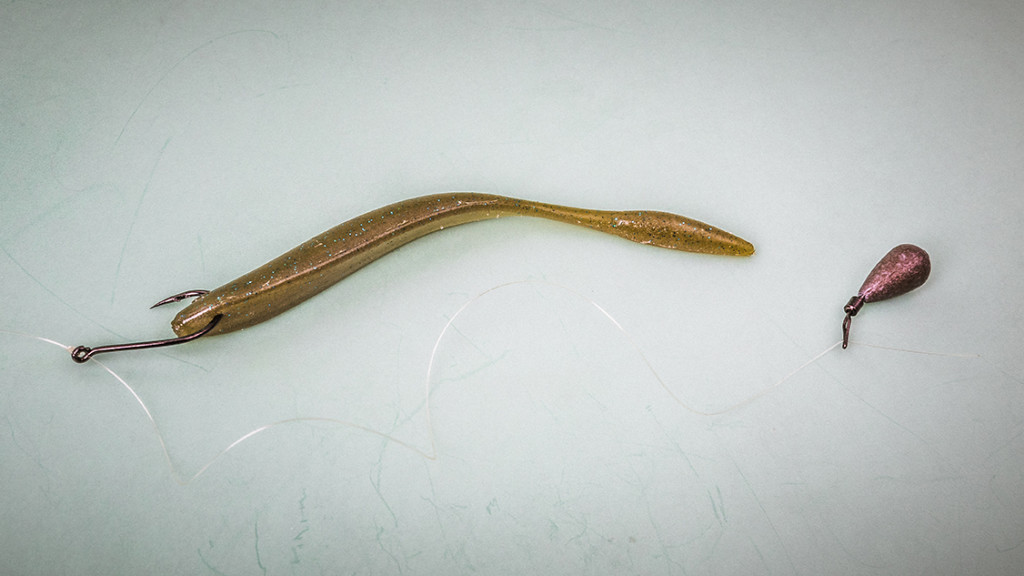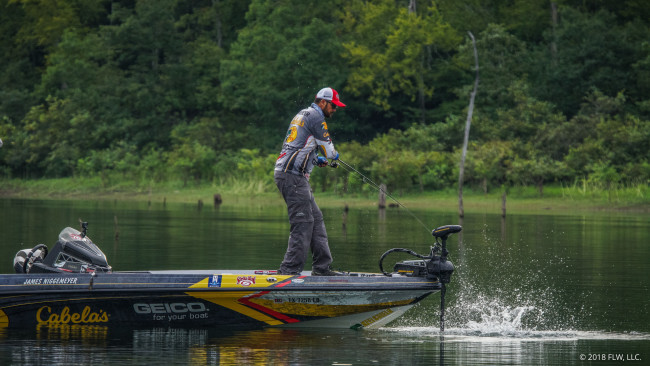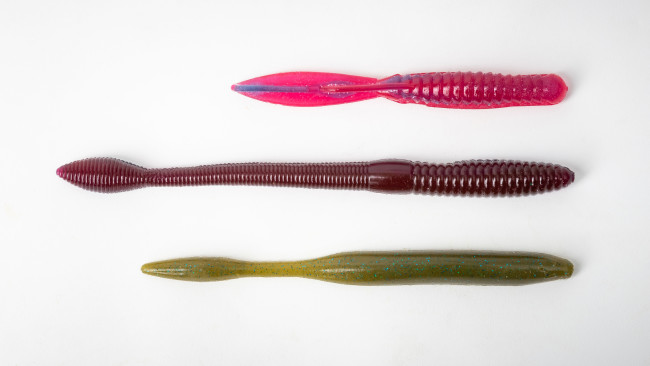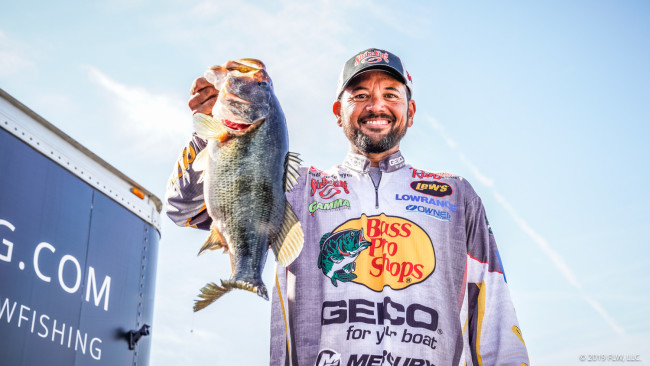The History of the Drop-Shot
Revisiting the rise of a favorite finesse rig

When I was growing up in Southern California, everyone threw a split-shot rig or used the doodling technique. Doodling was popularized by Don Iovino, who lived about 20 minutes from me. I used to go to his house and root through his tackle, and that’s where I first encountered it. The rig was simple: a 4- to 6-inch finesse worm with a bullet weight and a glass bead. Shaking it with a steady rhythm generated strikes on clear-water lakes. A split-shot rig was even simpler, with nothing but a lead shot that you crimped onto your line with some microscopic 3-inch baits.
Back then I was fishing Castaic, Casitas, Pyramid and other lakes with really clear water and heavy fishing pressure, so throwing a little finesse rig is just what I did. Funny thing is, I can’t even remember the last time I threw a split-shot rig or the doodling rig, but I can remember the first time I saw the rig that eventually replaced them: the drop-shot.
I guess I don’t know who was the first to rig up a drop-shot here or abroad, but it was definitely a Japanese development, and it was actually Aaron Martens that showed it to me first back in the mid-1990s. I had heard of it about five years before that, and I knew of a guy from Lake Perris in California who was using a rig with two hooks and a weight below it, but my history with the drop-shot as we now know it goes back to that first introduction by Aaron.
Once the word got out about the drop-shot, it was like no one threw a split shot or doodled anymore. It got to the point where every tournament was won on a drop-shot on those local clear-water, highly pressured impoundments.

At first, we didn’t even have drop-shot weights. We made them ourselves. I would buy 1/4-ounce split shot and crimp them onto the smallest barrel swivels I could find. I’m talking a tiny No. 14. Then I tied my line to that swivel. Other guys crimped a Texas-rig weight onto the line itself. I tried buying little bell sinkers, but I felt the wire wouldn’t turn fast enough like a swivel would inside a split shot.
Eventually, I saw my first drop-shot weight. It was a cylindrical weight with a line clip. They were expensive, and I remember thinking, Who’s buying that?Then, we got the first tungsten drop-shot weights, and it was more of the same. Now, if I’m drop-shotting, I couldn’t imagine not using tungsten.
Beyond tackle, the evolution of the drop-shot as a technique was really amazing. It was so much better than any of the other finesse presentations. You could even drop on fish you saw on the screen. I remember one of my buddies showing me how to do it. He’d spin around his graph at the console so he could see what was under the back and front of the boat, and we’d watch the fish go by and send a drop-shot down to them. The whole idea of catching one off the graph was new to me until then.
The technique just kept expanding. I have to admit that, at first, I made the mistake that a lot of bass fishermen do. I put the drop-shot in this little “box” and only used it in limited situations. I’d vertical fish it, and I’d cast it and work it just like a Texas rig. But I still wasn’t as open-minded as some other anglers that were really pushing the envelope.
I can remember the first time I heard of guys throwing a drop-shot on the California Delta. I thought that was so dumb. The Delta was a place to throw frogs and big square-bills and to flip. Boy, was I wrong. They started catching big ones on it.
What was even more interesting was how, at least in California, drop-shotting a little worm developed simultaneously with the transition of big swimbaits from tools for targeting trophy fish to tools to catch five bass in a tournament. I can remember talking to Byron Velvick about this years ago. He said the trend was to throw the smallest little finesse bait or the biggest, giant whatever. It’s like the whole “midsection” of bass baits wasn’t even getting used.
Now the drop-shot is the type of thing you throw anywhere (and so is a swimbait). I’ve seen it work too many times in places it shouldn’t. You won’t meet a pro angler today who doesn’t fish a drop-shot.

When I drop-shot, I really like to throw a finesse worm that’s around 4 1/2 inches long most of the time. My favorites are the 4-inch Strike King Dream Shot (bottom of image) and 5-inch Strike King Fat Baby Finesse (center of image). Sometimes I’ll go up to a 6-inch finesse worm, or down to a little bitty 3 1/2-inch Strike King Drop Shot Half Shell (top of image). I’ll even wacky rig a worm on a drop-shot if I’m not getting many bites fishing it the “normal” way, but for the most part I like a nose-hooked worm in the middle finesse size.
I feel like if you can get away with nose-hooking you’ll get more bites versus rigging it weedless or Texas style. The bait remains more “free” to move, and is less rigid on the hook.
I use a 1/0 or No. 1 Owner Mosquito or Light Mosquito for nose-hooking and wacky-rigging. If I do need to rig it weedless, I use a 1/0 Owner Cover Shot Worm Hook.
My weight is a bell-shaped Strike King Tour Grade Tungsten Drop Shot Weight, usually 1/4 ounce, rigged 10 to 12 inches below the hook. I increase the distance in very clear water, or sometimes in smallmouth water, and I shorten it when the water is dirty or I’m fishing for spawning bass on beds.
Like a lot of pros, I use a braid-to-fluorocarbon leader setup for drop-shotting. My main line is 10- to 12-pound-test braid, and I use an FG Knot to tie in a 7-pound-test Gamma Touch fluorocarbon leader.
Most people prefer the Palomar knot for tying on a drop-shot hook, but I actually use the Eugene slipknot.
The Palomar is probably the best knot if you tie it right, but, whatever it is that I do when I tie the Palomar knot, sometimes it breaks on the hookset. I try to remove all possibility of line failure, so when I first started experiencing the problem, I did some research and found an article done with Gary Klein and Shaw Grigsby. To anyone having trouble with fluorocarbon breaking on the hookset, they recommended the Eugene slipknot. It worked for me, and now I use it for everything except braid, which I tie using a Palomar.
Once I tie on my drop-shot weight with the Eugene slipknot, I pass the tag end back through the top of the hook eye, which keeps the hook pointed up most of the time. I also make sure the knot is centered and pointed up so the bait stays horizontal.

As you can tell, my drop-shot system is far more refined than it was 20 years ago when I was pinching split shot onto a swivel. Back in those days, it was up to the anglers to figure out how to make the rig work, and guys on the forefront like Aaron Martens helped a lot of us stay up on the latest tricks. Now, all the major tackle companies produce gobs of drop-shot worms, hooks, weights and other tackle, and we have incredible lines for light, finesse fishing.
So while I’m still a power-fisherman at heart, my history with the drop-shot and the modern tackle I use give me a high level of confidence that I can throw the finesse rig just about anywhere and put more big bass in the boat.